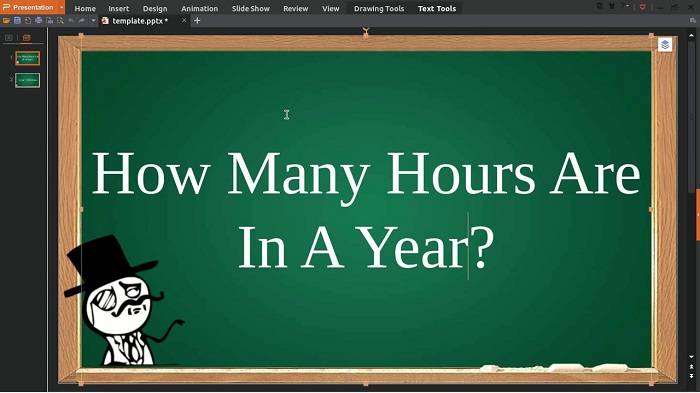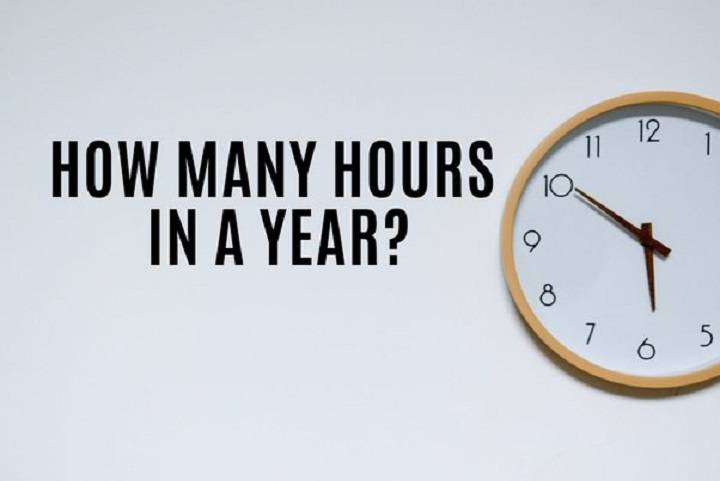Time is a fundamental aspect of our lives, and understanding how it is measured helps us organize our schedules, plan events, and manage our daily routines. One common question that arises is: “How many hours are there in a year?” This seemingly simple question has a more nuanced answer than one might initially think. This blog post explores the calculation of hours in a year, the variations due to leap years, and the practical implications of these measurements.
Basic Calculation of Hours in a Year
Standard Year Calculation

A standard year, also known as a common year, consists of 365 days. To calculate the number of hours in a standard year, follow these steps:
- Step 1: Start with the total number of days in a year.
- 1 year = 365 days
- Step 2: Multiply the number of days by the number of hours in a day.
- 1 day = 24 hours
- Total hours = 365 days × 24 hours/day
- 365 days×24 hours/day=8,760 hours365 \, \text{days} \times 24 \, \text{hours/day} = 8,760 \, \text{hours}365days×24hours/day=8,760hours
So, there are 8,760 hours in a standard year.
Leap Year Calculation
Leap years occur every four years to account for the extra approximately 0.25 days it takes for the Earth to orbit the Sun each year. A leap year has 366 days. To calculate the number of hours in a leap year:
- Step 1: Start with the total number of days in a leap year.
- 1 leap year = 366 days
- Step 2: Multiply the number of days by the number of hours in a day.
- 1 day = 24 hours
- Total hours = 366 days × 24 hours/day
- 366 days×24 hours/day=8,784 hours366 \, \text{days} \times 24 \, \text{hours/day} = 8,784 \, \text{hours}366days×24hours/day=8,784hours
So, there are 8,784 hours in a leap year.
Variations in Time Measurement
Leap Seconds
Occasionally, a leap second is added to Coordinated Universal Time (UTC) to account for irregularities in the Earth’s rotation. Leap seconds are added to maintain the synchronization of atomic clocks with astronomical time. While these adjustments are relatively rare and minor, they can slightly affect the total number of seconds in a year but do not significantly alter the hourly calculation.
Different Calendar Systems
Different calendar systems can have variations in year length. For instance, the Gregorian calendar (the most widely used calendar system) is the one we commonly refer to. However, other systems like the lunar calendar or the Hebrew calendar have different structures and year lengths. These variations can affect how hours are calculated in different cultural contexts.
Practical Implications
Financial Calculations
Understanding the number of hours in a year is essential for various financial calculations. For example, determining annual salaries, interest rates, and investment returns often involves converting years into hours to get precise figures.
- Example: If an employee is paid $50 per hour, their annual salary can be calculated as:
- Standard year: $50/hour × 8,760 hours = $438,000
- Leap year: $50/hour × 8,784 hours = $439,200
Project Management
In project management, knowing the number of hours available in a year helps in planning and resource allocation. It is crucial for estimating project timelines, scheduling tasks, and managing team workloads.
- Example: A project manager planning a year-long project needs to allocate tasks across the 8,760 or 8,784 hours available, considering weekends, holidays, and work hours.
Personal Planning
For personal planning, understanding the hours in a year can assist in setting goals, managing time effectively, and scheduling activities. It helps individuals to plan vacations, track progress on personal projects, and balance work-life commitments.
- Example: An individual planning a long-term goal, like learning a new skill, can allocate specific hours each week or month to achieve their objective within the year.
Leap Year Calculation Examples
Historical Leap Years
Leap years occur every four years, with some exceptions. To be a leap year, a year must be divisible by 4. However, if the year is divisible by 100, it must also be divisible by 400 to be a leap year. This rule ensures that the average year length remains consistent with the Earth’s orbit.
- Example: The year 2000 was a leap year because it is divisible by 400. The year 1900 was not a leap year because, although it is divisible by 100, it is not divisible by 400.
Future Leap Years
To determine if a future year will be a leap year, apply the same rules: divisible by 4, but if divisible by 100, must also be divisible by 400.
- Example: The year 2024 will be a leap year because it is divisible by 4 and not a century year. The year 2100 will not be a leap year because, although divisible by 100, it is not divisible by 400.
The Role of Time Zones
Global Time Zones
The number of hours in a year remains consistent across different time zones. However, time zones affect the local time of events and scheduling. For instance, a New Year’s Eve celebration in New York occurs at a different local time than in Los Angeles, even though both cities experience the same number of hours in a year.
Daylight Saving Time
Daylight Saving Time (DST) can affect the local perception of time but does not alter the total number of hours in a year. DST involves shifting the clock forward by one hour during warmer months to extend evening daylight.
- Example: When DST begins in spring, clocks are set forward by one hour, resulting in one less hour on that specific day. When DST ends in fall, clocks are set back by one hour, resulting in one additional hour on that specific day.
Interesting Facts About Time
Seconds in a Year
There are 31,536,000 seconds in a standard year and 31,622,400 seconds in a leap year. This high level of precision underscores the vast scale of time measurement.
- Calculation:
- Standard year: 365 days × 24 hours/day × 60 minutes/hour × 60 seconds/minute = 31,536,000 seconds
- Leap year: 366 days × 24 hours/day × 60 minutes/hour × 60 seconds/minute = 31,622,400 seconds
Time’s Impact on Life
Time significantly impacts various aspects of life, from biological rhythms to cultural practices. The concept of time influences how we live, work, and interact with the world.
- Example: Circadian rhythms are biological processes that cycle roughly every 24 hours, affecting sleep patterns, hormone release, and overall health. Understanding time helps in managing these rhythms effectively.
Related Post:
Shop Easter Dresses for Girls: A Comprehensive Guide to Finding the Perfect Outfit
The Color Purple (2023 Film) Showtimes: Everything You Need to Know About the Latest Adaptation
Austin Butler Movies and TV Shows: A Comprehensive Guide to the Rising Star’s Career
Understanding the number of hours in a year, including variations for leap years, is essential for accurate time management, financial calculations, project planning, and personal scheduling. Time measurement, while seemingly straightforward, involves complexities that affect various aspects of our lives. By comprehending these details, we can better organize our activities, make informed decisions, and appreciate the role of time in shaping our experiences.



